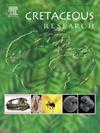埃及南部晚白垩世古环境演化和层序地层重建:孢粉学和地球化学代用资料的意义
IF 1.7
3区 地球科学
Q1 GEOLOGY
引用次数: 0
摘要
在坎帕尼亚-马斯特里赫特时期,长期的降温导致海平面上升下降,促进了古中高纬度碳酸盐台地沉积。在这里,从尼罗河流域(埃及)El-Sebaiya地区的坎帕尼亚-马strichtian最上层的Qusseir, Duwi和最下层的Dakhla地层中收集了85个岩石样本。采用了包括孢粉学、全岩石地球化学和总有机碳(TOC)分析在内的综合方法。在3个剖面中确定了4个孢粉相组合。PFA-A显示出高丰度的无定形有机物(AOM),表明沉积于浅海环境,而PFA-B显示出中等丰度的植物碎屑和AOM,表明沉积于河流三角洲至边缘浅海环境。PFA-C以植物碎屑为主,主要为不透明等维颗粒,具有河流三角洲环境特征,而PFA-D以中等水平的AOM和低植物碎屑的甲藻囊(dinocysts)为特征,表明浅海陆架环境。生物囊以类橄榄石形态为主,并结合磷矿带的普遍分布,反映了特提斯南部受上升流驱动的不同氧化还原条件下的高生产力环境控制。数据进一步允许重建三个三阶海侵回归序列。海侵体系域(TST)沉积物的特征是AOM增加,碳酸盐含量、Mn和Mn/Al比值升高,最大值对应大多数层序的最大泛洪面(MFS)。相反,退退体系域(RST)沉积物中植物碎屑增加,SiO2、Zr、Zr/Al、Ti、Ti/Al和Sr/Ca比值升高,其最大值对应最大退退面(MRS)。本文章由计算机程序翻译,如有差异,请以英文原文为准。
Paleoenvironmental evolution and sequence stratigraphic reconstruction during the Late Cretaceous in southern Egypt: Implications for palynological and geochemical proxy data
During the Campanian-Maastrichtian, long-term cooling drove eustatic sea-level fall, promoting carbonate platform deposition at mid-to-high paleolatitudes. Here, 85 rock samples were collected from the Campanian-Maastrichtian uppermost Qusseir, Duwi, and lowermost Dakhla formations at three sections in the El-Sebaiya area of the Nile Valley (Egypt). A comprehensive approach, including palynological, whole rock geochemistry, and total organic carbon (TOC) analyses, was performed. Four palynofacies assemblages (PFA) were identified in the three sections. PFA-A shows high abundances of amorphous organic matter (AOM), suggesting deposition in a shallow marine environment, whereas PFA-B exhibits moderate abundances of phytoclasts and AOM, indicative of deposition in fluvio-deltaic to marginal shallow marine conditions. PFA-C is dominated by phytoclasts, mainly of opaque equidimensional particles, characterizing a fluvio-deltaic environment, while PFA-D is characterized by moderate levels of AOM and dinoflagellate cysts (dinocysts) with low phytoclasts, pointing to a shallow marine shelf environment. Dinocysts are dominated by peridinioid forms combined with the common distribution of phosphorite belts, reflecting that the southern Tethys was controlled by upwelling-driven elevated productivity settings under varying redox conditions. Data further allowed the reconstruction of three third-order transgressive-regressive sequences. The transgressive systems tract (TST) sediments are characterized by an increase in AOM, coincided with elevated carbonate content, Mn, and Mn/Al ratios, with maxima corresponding to the maximum flooding surface (MFS) within most sequences. Conversely, the regressive systems tract (RST) sediments show an increase in phytoclasts and elevated SiO2, Zr, Zr/Al, Ti, Ti/Al, and Sr/Ca ratios, with their highest values corresponding to the maximum regressive surface (MRS).
求助全文
通过发布文献求助,成功后即可免费获取论文全文。
去求助
来源期刊

Cretaceous Research
地学-地质学
CiteScore
4.10
自引率
19.00%
发文量
235
审稿时长
12 weeks
期刊介绍:
Cretaceous Research provides a forum for the rapid publication of research on all aspects of the Cretaceous Period, including its boundaries with the Jurassic and Palaeogene. Authoritative papers reporting detailed investigations of Cretaceous stratigraphy and palaeontology, studies of regional geology, and reviews of recently published books are complemented by short communications of significant new findings.
Papers submitted to Cretaceous Research should place the research in a broad context, with emphasis placed towards our better understanding of the Cretaceous, that are therefore of interest to the diverse, international readership of the journal. Full length papers that focus solely on a local theme or area will not be accepted for publication; authors of short communications are encouraged to discuss how their findings are of relevance to the Cretaceous on a broad scale.
Research Areas include:
• Regional geology
• Stratigraphy and palaeontology
• Palaeobiology
• Palaeobiogeography
• Palaeoceanography
• Palaeoclimatology
• Evolutionary Palaeoecology
• Geochronology
• Global events.
 求助内容:
求助内容: 应助结果提醒方式:
应助结果提醒方式:


